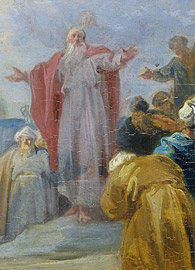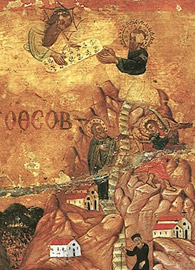Selections From Israel's Story Week 3
Covenant Ratification: Exodus 24
By Sara Koenig
Seattle Pacific University Associate Professor of Biblical Studies
Read this week’s Scripture: Exodus 24
08:14

 Enlarge
Enlarge
Last week’s lectio discussed the Ten Commandments, but this one moves back to a narrative. In fact, this is the first story that takes place after the body of text known as the Book of the Covenant, laws contained in Exodus 20:22–23:33. All of the laws are understood as terms of the covenant between God and Israel, and this story tells about what happened when the terms of the covenant between God and Israel were accepted.
Sealing the Covenant
The story starts with a command to a select group of people to go up to the mountain: Moses, Aaron, Nadab and Abihu (the two sons of Aaron; compare Exodus 6:23), and 70 [Author’s Note 1] of the elders of Israel (Exodus 24:1). But within the first two verses there is a clear contrast between coming up to the LORD and coming near to the LORD. Only Moses can do the latter; the others are to keep their distance. If the elders are distinct from the people (who remain at the foot of the mountain), Moses is distinct from the elders. This is a theme that will be repeated throughout the passages we will read this summer.
Notice the people’s response to the LORD’s words and ordinances in 24:3. After Moses has told them “all the words of the LORD, and all the ordinances,” “with one voice” they agree. Then Moses writes it down so that they have it in writing, something that is typical of treaty documents in the ancient Near East. It has been suggested that Moses sets up the pillars to act as witnesses to the treaty, similar to the stone that Joshua sets up as a witness in Joshua 24:27.
The altar that Moses builds is used to sacrifice oxen, as offerings of well-being. Leviticus 3 gives more details about that type of offering, which typically is not used for expiation, but tends to be spontaneously motivated.
Offerings of well-being also allow the people to eat the meat of the animal sacrificed. In Exodus 24:6-8, we read that the blood from these animals is collected. Half of it is dashed on the altar, while the other half gets thrown on the people. Some commentators suggest that the altar is representative of God, which would mean that the blood of the covenant is put on both God and the people.
In other words, both parties are responsible for keeping the covenant (compare Hebrews 9:11–22). This gruesome act was a way to literally seal the covenant in blood. Though the people spoke their words of assent a second time after Moses had read the written words to them, the covenant is made real by words and the concrete action of putting blood on them. The second time that the people say, “All that the LORD has spoken we will do,” they add the promise, “and we will be obedient” (Exodus 24:7; compare 24:3).
Moses, Aaron, Nadab and Abihu, and the 70 Elders Approach Mount Sinai
After the covenant is sealed, Moses, Aaron, Nadab and Abihu, and the 70 elders go up to the mountain. On the one hand, the text is incredibly blunt, “and they saw the God of Israel” (24:10)! But, on the other hand, the actual description of what they see is very careful. Verse 17 refers to “the appearance of the glory of the LORD” as being “like a devouring fire on the top of the mountain in the sight of the people of Israel.” We hardly get a specific image of God from such description. Even when the select number see God, there are plenty of similes that move away from too much concrete imagery: “under his feet there was something like a pavement of sapphire stone, like the very heaven for clearness” (24:10).
In fact, it seems as if Moses, Aaron, Nadab and Abihu, and the elders see only God’s feet, and nothing more. There are references to a sapphire stone in Exodus 28:18, Job 28:6 and 16, Isaiah 54:11, and Ezekiel 1:26, but those seem to be referring to a lapis lazuli, while the description in our text is of something blue, but clear. It is as if to suggest that what they saw was beautiful, but of a beauty beyond our concrete imagination.
After they eat and drink, the party presumably breaks up. Moses alone is to proceed up to the mountain and wait for God, who will give him the stone tablets on which God has written the laws (Exodus 24:12). Still, others are mentioned — Joshua, who is identified as Moses’ assistant; the elders; Aaron; and Hur [Author’s Note 2].
Moses’ instructions to the elders carry a weight of foreshadowing: he tells them to wait for his return, but if there is a dispute, they can bring it to Aaron and Hur. Actually, the text literally says, “wait for us until we come to you again” (Exodus 24:14, emphasis mine), but then only Moses goes up to the mountain (24:15, 18). It appears as if Joshua remains somewhere between the people at the base of the mountain, and Moses and God on the top (compare Exodus 32:17). Indeed, Exodus 32 will give us the return of Moses and Joshua to the Israelite camp, but Aaron will not prove to be the substitute for Moses that one hoped he would be.
Moses Ascends the Mountain

 Enlarge
Enlarge
When Moses does go up on Mount Sinai, the cloud covers it, and the glory of the LORD settles on it, similar to Exodus 19. The cloud and God’s glory are linked at the end of Exodus , which describes God’s presence in the tabernacle, “Then the cloud covered the tent of meeting , and the glory of the LORD filled the tabernacle. Moses was not able to enter the tent of meeting, because the cloud settled upon it and the glory of the LORD filled the tabernacle” (Exodus 40:34–35).
It is noteworthy that Moses has to wait for six days before he hears from God on the seventh day. The people had to only wait three days before they witnessed the divine presence in Exodus 19:11. God does not speak right away. We are not told what Moses does during those six days of waiting: some speculate that he was purifying himself in preparation to encounter God. Perhaps this, too, was a time when Moses had to have faith that God would do what he said.
Exodus 24 is, overall, a fairly brief story, but is profoundly important for Israel’s story as a whole. It tells us that the people — apparently willingly — accept the terms of the covenant with God. Twice they affirm that they will do all that God has spoken. The covenant is sealed in blood — representing life — and is to be upheld by both covenantal partners. God is witnessed to, visibly, but also with some distance. And Moses is singled out as the one who is invited to come into God’s intimate presence.
This story also finds resonance in the New Testament story of the transfiguration (Matthew 17:1–9; Mark 9:2–10; Luke 9:28-32), especially as Matthew and Mark specify that it was “six days later” (Matthew 17:1; Mark 9:2). Peter’s desire to build tents so that they can remain up there is significant in light of what is to come in Exodus. For as Moses remains on the mountain, for 40 days and 40 nights, things back in the camp will not go so well.
Questions for Further Reflection:
- Do you agree with the description of Moses throwing the blood on the altar and the people as “a gruesome act”? Why was blood connected to the sealing of a covenant? What does that imply about the nature of this covenant?
- Re-read what the Lectio writer says about the act of sealing the covenant. What difference does it make that both parties (Israel and God) have an aspect of the treaty to uphold? How do we see that played out through the text in Hebrews 9:11-22 that the writer notes?
- Why is the text so careful about (not) describing what God looks like? What is problematic about Moses and the others seeing God? How might these interactions inform how we should interact with God today? What difference do the life, death, and resurrection of Jesus make on such reflections?
- Two times the Israelites say “all that the LORD has spoken we will do…” (Exodus 24:3, 7). Does it seem to you like their agreement is voluntary, or somehow coerced? Why? What difference does it make? Have there been times in your life when you agreed to do something, and then did not? What were the consequences, if any?

This work is licensed under a Creative Commons License.




